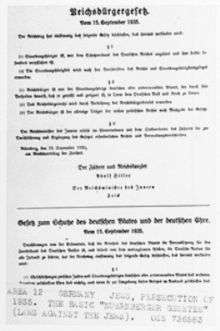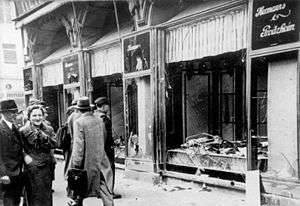Anti-Jewish legislation in prewar Nazi Germany

Antisemitism and the persecution of Jews represented a central tenet of Nazi ideology. In their 25-point Party Program, published in 1920, Nazi Party members publicly declared their intention to segregate Jews from "Aryan" society and to abrogate Jews' political, legal, and civil rights. Nazi leaders began to carry out their pledge to persecute German Jews soon after their assumption of power. The first major law to curtail the rights of Jewish German citizens was the "Law for the Restoration of the Professional Civil Service" of April 7, 1933, which forced all "non-Aryans" to retire from the legal profession and civil service.
The new Civil Service Law was the German authorities' first formulation of the so-called Aryan Paragraph, a kind of regulation used to exclude Jews (and often by extension other "non-Aryans") from organizations, professions, and other aspects of public life. In April 1933, German law restricted the number of Jewish students at German schools and universities. In the same month, further legislation sharply curtailed "Jewish activity" in the medical and legal professions. Subsequent laws and decrees restricted reimbursement of Jewish doctors from public (state) health insurance funds.
Nuremberg Laws
At their annual party rally held in Nuremberg in September 1935, the Nazi leaders announced new laws which institutionalized many of the racial theories prevalent in Nazi ideology. These "Nuremberg Laws" excluded German Jews from Reich citizenship and prohibited them from having sexual relations or marriages with Aryans ("German or related blood"). The laws also deprived the jews of basic political rights; they had no voting rights and couldn't hold a political office.[1] violation of this law was punishable as "racial defilement". Ancillary ordinances to these laws deprived them of most political rights. Jews were disenfranchised and could not hold public office.
The Nuremberg Laws did not identify a "Jew" as someone with particular religious beliefs. Instead, the first amendment to the Nuremberg Laws defined anyone who had three or four Jewish grandparents as a Jew, regardless of whether that individual recognized himself or herself as a Jew or belonged to the Jewish religious community. Many Germans who had not practised Judaism or who had not done so for years found themselves caught in the grip of Nazi terror. Even people with Jewish grandparents who had converted to Christianity could be defined as Jews.
In the weeks before and during the 1936 Winter and Summer Olympic Games held in Garmisch-Partenkirchen and Berlin, respectively, the Nazi regime actually toned down much of its public anti-Jewish rhetoric and activities. The regime even removed some of the signs saying "Jews Unwelcome" from public places. Hitler did not want international criticism of his government to result in the transfer of the Games to another country. Such a loss would have been a serious blow to German prestige. Likewise, Nazi leaders did not want to discourage international tourism and the revenue that it would bring during the Olympics year.
In 1937 and 1938, German authorities again stepped up legislative persecution of German Jews. The government set out to impoverish Jews and remove them from the German economy by requiring them to register their property and not allowing them to make money. The government reduced Jewish owned businesses in Germany by 2/3.[2] Even before the Olympics, the Nazi government had initiated the practice of "Aryanizing" Jewish businesses. "Aryanization" meant the dismissal of Jewish workers and managers of a company and/or the takeover of Jewish-owned businesses by non-Jewish Germans who bought them at bargain prices fixed by government or Nazi party officials. In 1937 and 1938, the government forbade Jewish doctors to treat non-Jews, and revoked the licenses of Jewish lawyers to practice law.
Law for the Restoration of the Professional Civil Service [2]
The Law for the Restoration of the Professional Civil Service limited the personal lives of jews in Germany. It said that jews and other non-aryans were not aloud to serve any government position such has teachers, professors, and judges. The new Civil Service Law was the first formulation of the aryan paragraph. This excluded jew from organizations, professions, and many other aspects of life. The Law for the Restoration of the Professional Civil Service lead to many laws restricting Jewish students in schools and restricting Jewish lawyers, notaries, doctors, and tax consultants. Jewish lawyers and notaries were no longer aloud to work with legal matter, and Jewish doctors were not aloud to work on non Jewish patients. The Law for the Restoration of the Professional Civil Service was a big step to the limiting of the Jewish peoples personal lives, and prime example of the mistreatment of the jews in prewar Germany.
Kristallnacht

Kristallnacht was an incident when Nazis in Germany attacked jewish citizens. They torched and attacked jewish establishments. These establishments included synagogues, jewish owned businesses, jewish schools, and jewish homes.[3] During Kristallnacht, close to 100 jews were killed and thousands were arrested and sent to concentration camps.[3] This was the start of organized Nazi attacks. There was no clear instructions on how to execute the violence, so it caused the destroying of jewish property and humiliating and inhumane treatment.[4] The events of Kristallnacht foreshadowed the Holocaust.[3] Following the Kristallnacht (commonly known as "Night of Broken Glass") pogrom of November 9–10, 1938, Nazi leaders stepped up "Aryanization" efforts and enforced measures that succeeded increasingly in physically isolating and segregating Jews from their fellow Germans. Jews were barred from all public schools and universities, as well as from cinemas, theaters, and sports facilities. In many cities, Jews were forbidden to enter designated "Aryan" zones. German decrees and ordinances expanded the ban on Jews in professional life. By September 1938, for instance, Jewish physicians were effectively banned from treating "Aryan" patients.

On 17 August 1938, German authorities decreed that by January 1, 1939, Jewish men and women bearing first names of "non-Jewish" origin had to add "Israel" and "Sara," respectively, to their given names (Namensänderungsverordnung). For their children, only a restricted number of "Jewish" first names were allowed; most of these names were highly unusual, and many were likely to attract derision, e.g. Geilchen (Slut). Every Jew was obliged to carry identity cards that indicated their Jewish heritage, and, in the autumn of 1938, all Jewish passports were stamped with an identifying letter "J". Kristallnacht and the events following it showed the Nazi regime that they could count on nation wide support of antisemitism from the general public.[4] As the Nazi leaders quickened their preparations for the war of conquest that they intended to unleash on Europe, antisemitic legislation in Germany paved the way for more radical persecution of Jews.
Timeline of Ant-Jewish Legislations and Movements in Prewar Germany
During the prewar Nazi Germany period (1933-1939) there were more than 400 laws, decrees, and other type of regulations thats goal was to restrict jews. There were national laws that affected all the jews, and there was state, region, and city laws that only affected the jews in those communities. These regulations limited jews in all aspects of life, both public and private. Almost all people were involved in the support of Anti-Jewish legislation in some way, whether it was passive agreement or direct involvement.[2]
1933: [5]
- March 31: A decree in the city of Berlin said that Jewish doctors were suspended from the city's charity services.
- April 7: There was a law for the Restoration of the Professional Civil Service. This law removed all jews from government service. Also a law on the Admission to the Legal Profession forbade the jews from taking the bar exam, which is a test needed to become a lawyer.
- April 25: A law about overcrowded Schools and Universities limited the number of Jewish students allowed in public schools.
- July 14: The Jewish people lost citizenship because of a De-Naturalization Law. This took citizenship away from all jews, including naturalized jews and undesirables.
- October 4: The jews were banned from editorial post by a law on editors.
1934: [2]
- The national Nazi Government forbade Jewish actors from performing on the stage or the screen.
- Local governments issued regulations on other aspects of Jewish life. The jews were no longer allowed to slaughter animals which prevented them from obeying Jewish dietary laws.
1935: [5]
- May 21: A law was made on military participation that outlawed Jewish officers in the army.
- September 15: The Nazi leaders announced the Nuremberg Laws.
1936: [5]
- January 11: An Executive Order on the Reich Tax Law forbade jews from being a tax consultant.
- April 3: The Jewish people were banned from the veterinary profession by the Reich Veterinarians Law.
- October 15: The Reich Ministry of Education banned Jewish teachers from teaching in public schools.
1937: [5]
- April 9: The mayor of Berlin ordered public schools to not allow Jewish students to attend the public schools until further notice.
1938: [5]
- January 5: Jews were forbade from changing their names by a law on the Alteration of Family and Personal Names.
- February 5: A law on the profession of auctioneer banned jews from being auctioneers.
- March 18: Jewish gun merchants were excluded by the Gun Law.
- April 22: Jewish owned businesses were forbade from changing their names. This decree's goal was to protect against the camouflage of Jewish businesses.
- April 26: All Jewish people were required to report all property worth over 5,000 reichsmarks.
- July 11: The Reich Ministry of the Interior banned the jews from health spas.
- August 17: An executive order on the law on the alteration of family and personal names required all jews to adopt names. For women "Sara" and for men "Israel".[2]
- October 5: The Reich Interior Ministry invalidated all German passports owned by jews. The only way for the jews to get their passports validated was to get a J stamped on it.
- November 12: All Jewish owned businesses were closed by a decree on the Exclusion of Jews from German Economic Life.
- November 15: All Jewish children were expelled from public schools by the Reich Ministry of Education.
- November 28: The freedom of movement was highly restricted by the Reich Interior Ministry.
- November 29: The Reich Interior Ministry also forbade jews from keeping carrier pigeons.
- December 14: An executive order on the Law on the Organization of National Work Canceled all state contracts held with Jewish owned firms in order to attack the jews economically.
- December 21: A law banned all jews from being in the occupation of midwives.
1939: [5]
- February 21: A decree said that jews to surrender on precious metals and stones that they owned.
- August 1: The president of the German Lottery outlawed the sale of lottery tickets to jews.
- September 1: World War Two Started.
Notes
- This article incorporates text from the United States Holocaust Memorial Museum, and has been released under the GFDL.
External links
- United States Holocaust Memorial Museum - Anti-Jewish Legislation in Prewar Germany
- Images of a 1938 German "J" Jewish passport from www.passportland.com
- List of "Jewish" first names (August 1938) - Name List
References
- ↑ King, Henry (2002). "THE LEGACY OF NUREMBERG". Case Western Reserve Journal of International Law: 335–336 – via ProQuest.
- 1 2 3 4 5 "ANTI-JEWISH LEGISLATION IN PREWAR GERMANY". United States Holocaust Memorial Museum.
- 1 2 3 "Remembering Kristallnacht". The Jerusalem Report – via ProQuest.
- 1 2 Doescher, Hans (Spring 2011). "Kristallnacht 1938". ProQuest. Shofar.
- 1 2 3 4 5 6 "EXAMPLES OF ANTISEMITIC LEGISLATION, 1933–1939". United States Holocaust Memorial Museum.